Figure embroidery is a topic that absolutely captivates me.
I started my whole adult Embroidery Journey (that is, pursuing embroidery with Lusty Gusto, avidly collecting, reading, examining, attempting) while studying the history of art in college.
Ever since then, I’ve built my own collection of embroidered pieces and photographed others – especially on church vestments and vesture – in order to study them closely.
Now, if you’re not really into ecclesiastical figure embroidery, that’s ok – the techniques can translate well into any figure embroidery, whether church-related or not.
And true, there are other ways of embroidering faces and figures, besides the somewhat formal styles presented in church embroidery. For example, there are contemporary interpretations in embroidered portraits, like those by fiber artist Cayce Zavaglia.
I think one thing that really mesmerizes me about this subject is that the assortment of extant examples of such embroidery from various ages teaches us so much about the whole development of embroidery styles, techniques, and even materials – the development, in short, of the art of embroidery through the ages.
An important point to consider about figure embroidery is how it is meant to be viewed. The embroiderer will most certainly embroider differently, depending on the way the embroidery is supposed to be seen.
To illustrate this point, let’s take a look at some figure embroidery.
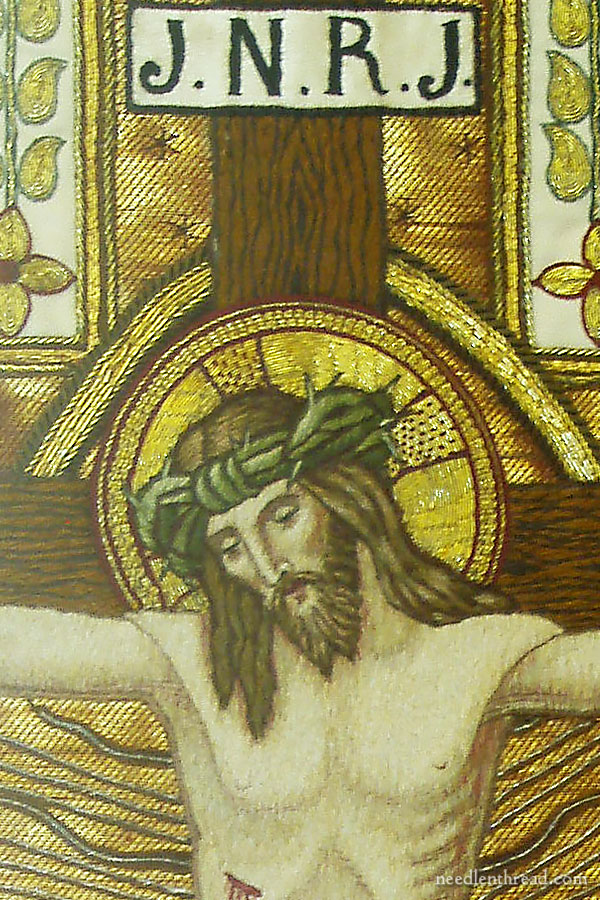
This particular piece of ecclesiastical embroidery is a Crucifixion scene on a chasuble in the collection at the Benedictine monastery in Clyde, Missouri. It was photographed with permission, but under glass, which accounts for the glare.
The figures are completely embroidered, and from this distance in the photo, the face and its features are quite clear and even bold, in a sense.
Embroidery that’s meant to be seen from a distance requires a lot of contrast. From a distance, though, it’s really hard to imagine just how many stitches and how much color is in that face that is really no more than 3″ in length.
When you see it from a distance, the stitches and colors blend together smoothly, to create an effect that looks much like painting.
But let’s zoom in a bit:
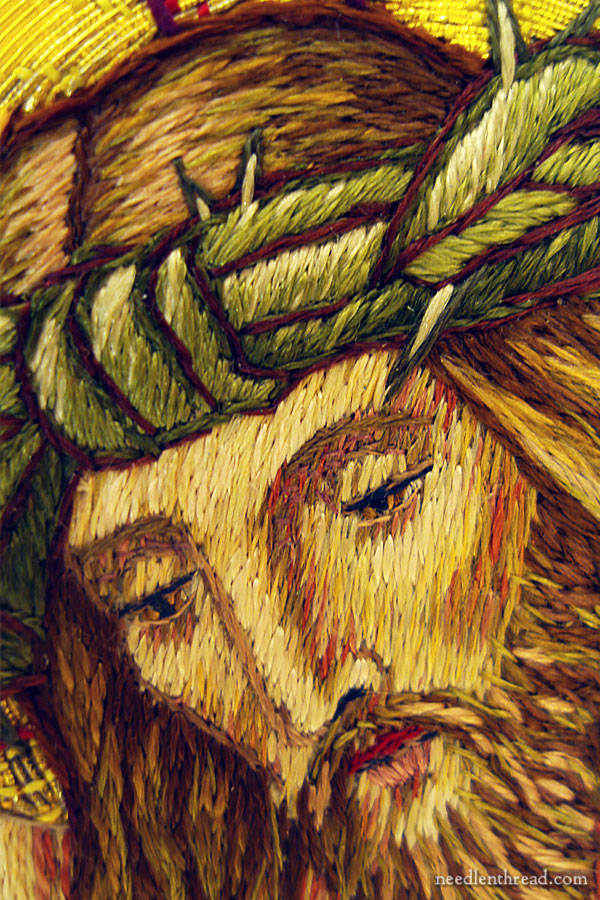
When viewed up close, magnified, we see the sketchiness of the stitches and presence of all kinds of color, from yellows to reds. We see what looks like irregular, even messy stitching. We see odd lines of stitches along the nose, on the eyelids, and the sides of the face.
Like an impressionist painting, the closer you get, the more muddled the image. Step back to see it from afar, and the importance of perspective – just like the embroidered image itself – becomes very clear.
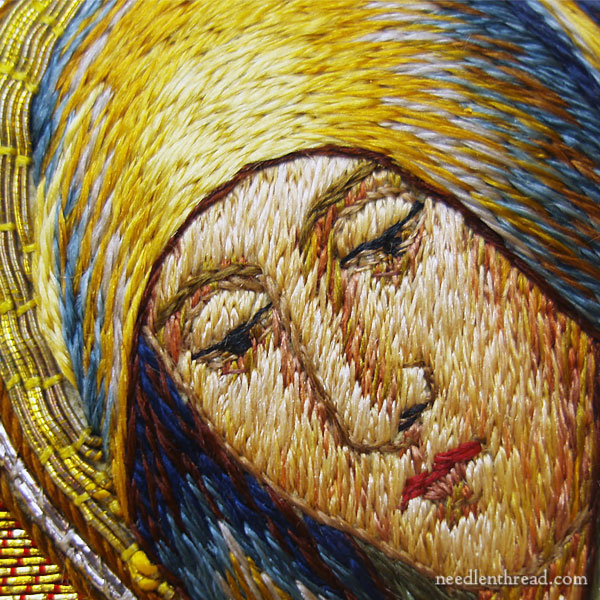
I’ve shown this photo before on Needle ‘n Thread. It’s one of my favorite examples of how perspective effects how a piece of embroidery is seen.
This figure is on the same chasuble – it’s an image of the Virgin Mary at the foot of the cross. In the photo above, the embroidery looks equally as sketchy and we see, again, an interesting mix of colors. On the nose and above the eye, dashes of a deep coral red are mixed in with the skin tones and browns.
Let’s look really, really close at the embroidery threads:
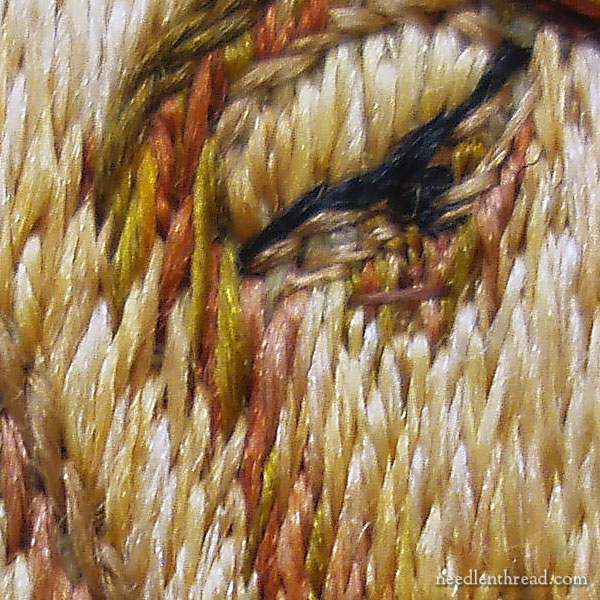
They look like relatively heavy threads, because they are magnified here. They’re fine threads, through, I assure you! Threads have to be pretty fine to get this much detail into such a small space.
Notice that you don’t see any tight twisting in the thread (which would increase the textural reflections of light on the silk and take away from the smooth finish). Rather, the threads are softly twisted, almost flat silk, like the silk filo manufactured in the late 1800’s and early 1900’s by companies like Belding Brothers.
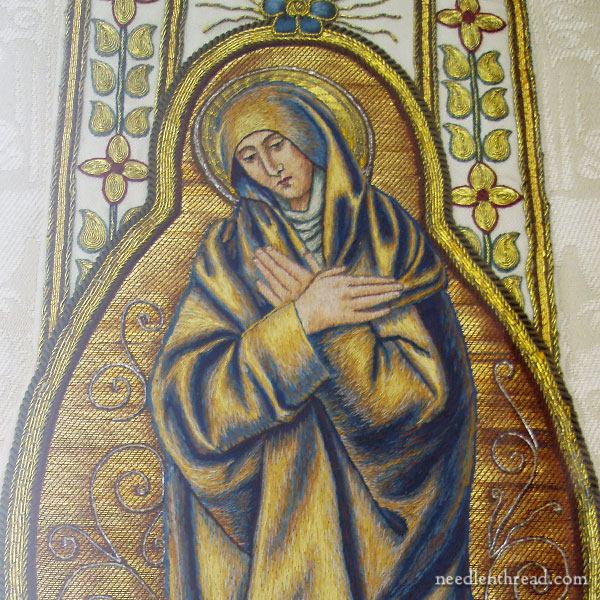
Here’s the same image, stepping back.
Pretty impressive, isn’t it, how all those stitches, all those colors, blend so nicely into a very discernible face with a serene expression, when viewed from a distance?
I mentioned earlier this year that I’ll be experimenting with figure embroidery in 2015. I haven’t made a whole lot of progress in my explorations, but one of these days, we’ll re-visit the subject again and I’ll show you what have managed.
If you have any questions, please feel free to leave a comment below!
Coming Up on Needle ‘n Thread
I’ll be a taking a short break from the blog this weekend to celebrate Easter with my family, so Happy Easter in advance!
I’ll be back on Monday, to announce the winner of the Hand & Lock embroidery class give-away and to share some interesting newsy bits.
Have a wonderful weekend!







Thank you for this wonderful page on figure embroidery. Looking forward to more. Have a wonderful Easter!
What a stupendous lesson this morning on figurative embroidery. I am so appreciative of all you do to teach and educate us. My printed file of your daily informative information continue to grow. Thank you so very much for what you.
For some reason I am not “into” people/portraits, but this was still fun to read and enjoy. Who knows, maybe I’ll try a fairy some day and then I’ll have to do some studying. 🙂 These are beautiful to see. Thanks
Have a happy Resurrection Sunday, Mrs. Corbet! And have a wonderful time with your family.
Mary, Thanks for the details in your explanation. It is all so fascinating.
Happy Easter
Victoria in VA
Dear Mary, thank you for another great, informative and very interesting article. The face and hands have always been, for me, the most difficult parts to do well, to make the stitching of the face and features turn out to my satisfaction.
what beautiful pictures. I so enjoy those pictures. I would love to learn how to do that kind of work. I live in a small town and really like what you do. To be able to learn would be spectacular Thank you for sharing Are there books you would recommend for me to get and study?
Happy Easter! He is Risen!
Dear Mary,
What a pleasant suprise to find your blog post waiting for me upon return from mass on Good Friday! And what a lovely pictures you took. My favourite vestments atelier Leo Peters often only did detailed faces and far less stitching on the rest of the figures. The rest of the figures were painted on with paint and then some details stitched on. A very interesting technique.
Happy Easter to you!
Jessica
Dear Mary
I’m fascinated by figure embroidery and how it is achieved, when you view the photos above up close you can see how messy the stitching is but from a distance they look professionally embroidered and the different colour threads used is interesting. I do hope you re-visit figure embroidery as I would be interested to see your perspective on this form of embroidery. I’ve only tried figure embroidery once with the Guardian Angel that you wrote about in July 2012 I found the face very difficult especially the eyes I think I must have ripped them out about 6-7 times before completing it, I’m still not happy with the eyes. I hope you have a great Easter with your family and a good rest and look forward to reading your blogs next week.
Regards Anita Simmance
Mary, what a wonderful article and so appropriate on this Good Friday. I am always amazed when I see ecclesiastical embroidery and try to imagine the person who has done such incredible work. I also marvel at their eyesight.
Thank you for always coming up with such interesting and helpful posts.
Happy Easter to you and your family.
Terry
Happy Easter, Mary! Thank you for sharing so much beauty and happiness through your embroidery thoughts. It brightens my whole day!
Love,
Sarah
I am very poorly at the moment ..recovering from a big op …how nice to read your blog today , a particularly interesting entry . Have a love Easter with your family . love Debbie x
I really appreciate your attention to this subject. It is hard to “stitch w/ perspective” in mind when you are right on top of the embroidery putting in one stitch at a time. Eyeballs are amazing things!! thank you.
I’m fascinated by your photos and looking forward to trying some of this figure embroidery. One thing that I have really noticed in the little I have done is the importance of the direction of the stitching. Eyes across the face and nose going down make faces look more real, for example. My Hobbie Hobbie picture has fingers that look broken, bu of course I embroidered it when I was about 8-9 years old. It is time to try again. Happy and Blessed Easer to you and your family!
The patience and artistry that go into works like these is just amazing. So beautiful. Happy Easter!
thank you for this so appropriate. For today embroidery. happy Easter to you and your family
Thank you! Have a very blessed Easter, Mary!
THANK YOU Mary !!!! I used your instructions on transferring with freezer paper and it was a breeze…what a delite when one is anxious to jump in and embroider instead of all the “prep work”. You are a gem, a life saver, a “know it all” and i am so glad that you are there for us. Mwaw !!!!! big hugs and kudos !
Thanks, Trini – but just be warned that the ink from an inkjet printer is rarely colorfast, so if you plan to wash your embroidery, test it first! You might try ironing with a hot iron, to set the ink – but still, test it, if you plan to wash your work!
Mary, thank you for sharing todays information! The work is so beautiful at a distance, but remarkable because the stitchers knew just what colors to use to get the effect they wanted. I use my imagination when it comes to blend colors in embroidery, but the mere thought of trying to do what is supposed to be skin makes me dizzy.
Right now I would most likely take a photo and do an extreme close up so that I can match threads to the photo’s colors, and then I can mark up a printed copy of the photo to make sure that the proper thread color is used in the right places!
Thank you, Mary! This kind of colour blending fascinates me, whether embroidered or painted. Not that it works, but that the artist is able to visualise what the effect will be. That takes amazing skill.
I’ve noticed this on my own stitching. Thank you for sharing and making me feel less worried about my “messy” stitching!
hola Mary .una genial charla sobre bordado y expresion manos y emocionante ver lo que quiso expresar la artista gracias por el gran aporte
Absolutely LOVE these! Thank you for sharing!
Thank you for sharing:-)
Thank you for sharing that beautiful work, Happy Easter to you and your family!
Dear Mary,
I hope you and your family have a Happy and Blessed Easter.
In Christ,
Helen
“I mentioned earlier this year that I’ll be experimenting with figure embroidery in 2015. I haven’t made a whole lot of progress in my explorations, but one of these days, we’ll re-visit the subject again and I’ll show you what have managed.”
I can’t wait!!!!!
Happy Easter!
Dear Mrs Corbet,
I have some experience in needlepointing, and I would love to embroider this Face of Christ for my brother who is a priest in France. However, I am afraid not to succeed by myself! Please could you advise me? have you done some work of this type urself? I love this beautiful crucifixion. I would need a very good picture which could be enlarged, and do you have any idea of how I should start and proceed?
Thank you so much for your advice and help!
Yours,
Bernadette Sadek (I am French and live in Limoges, France)
Hello, Bernadette – I’m afraid there are not many books on this topic. You might take a look at this article: https://needlenthread.wpengine.com/2007/08/church-embroidery-book-online.html
There, you will find links to a free online version of Lucy Mackrill’s book. She writes about the topic a little bit. Yes, I have done some figure embroidery, but not much, and not nearly as successfully as the embroidery shown in this chasuble! It takes a lot of practice!